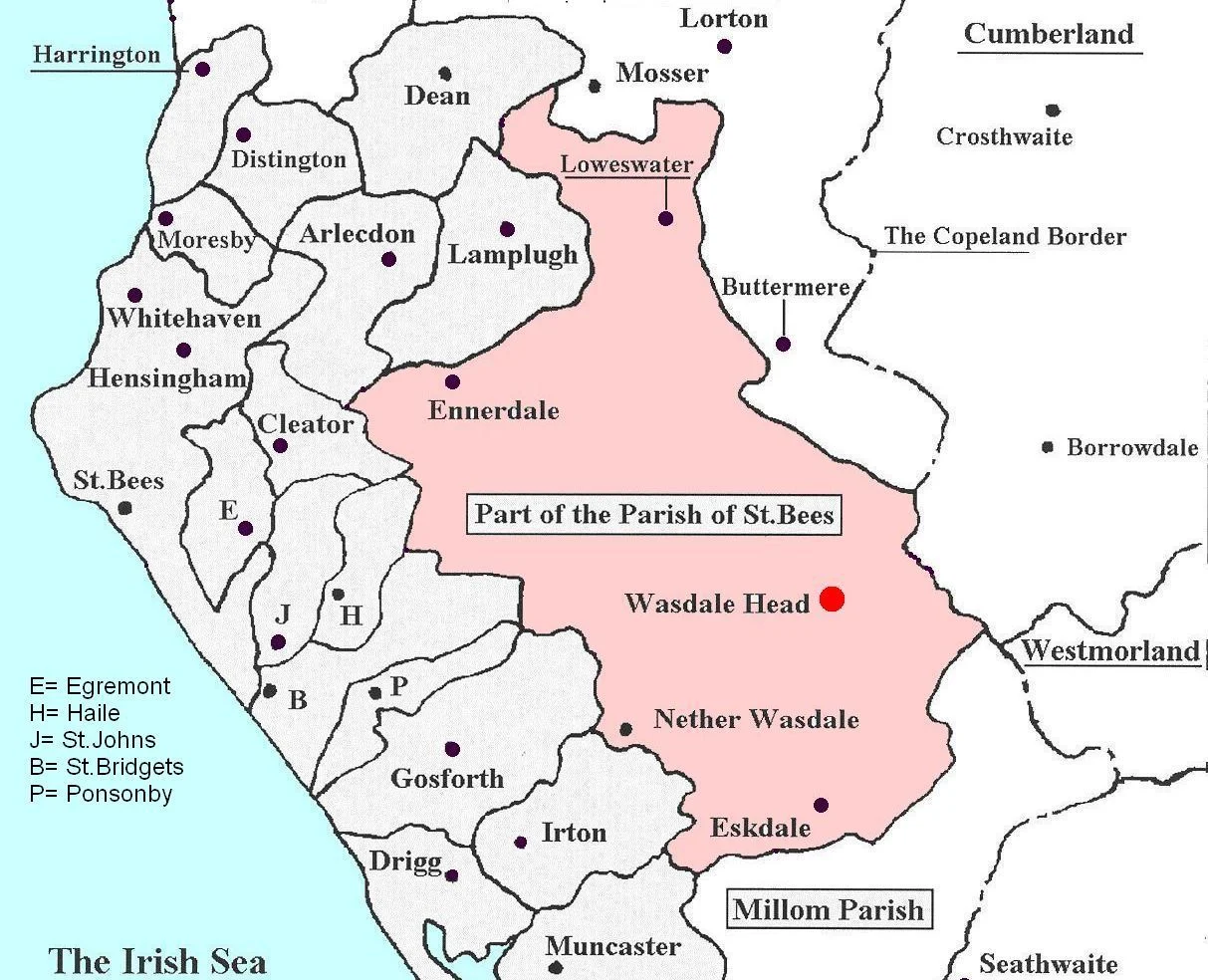Introduction
Author: Nev. Ramsden
I must point out that there are two Wasdaleheads in today's Cumbria. The first being in the Wasdale valley situated on the west side of Cumberland, whilst the other is in the Manor of Hardendale & Wastdale - south of Shap - in Westmorland. They both had a family with the place name as its surname. The Westmorland family name is normally written as Wastell and it is described in an article written for the TCWAAS 1900 pp147-151 and were obviously 'well to do'; whilst the Cumberland family name is written as Wasdale and were yeoman sheep farmers. The genealogist must proceed with caution once these two families move away from their home ground. It is possible that both these families are now extinct - the Wastells died out with three daughters the last of whom died in 1892.
The Wasdale families who lived at the head of the Wasdale valley were an extraordinary family in that they all lived in one small hamlet of seven farms and managed to produce a male heir each generation from the time of the introduction of the family surname, probably around the 12 century, until the death of Aaron Wasdale in 1837. The last male member of the last family was his brother John Wasdale who died in St.Bees in 1848. The last female Wasdale was Ann (Nanny) Wasdale who died at Bowderdale in 1858. In recognition of her status as the last member and matriarch of the clan - over 200 people from all parts of the lake district attended her funeral where the traditional funeral fare of 'spiced broth' was served to the mourners. All though Nanny was the last surviving member with the family name, she was succeeded by daughters & nieces but by then they were all married. The last of them were Mary Ann Hudson who died at Bootle in 1891 and Mary Ann Sewell living at Askam-in-Furness in 1901. Mary Ann Sewell was the last Wasdale to be born in the valley (1845) and she married Isaac Sewell at Netherwasdale in 1869
This family can be followed from the earliest manor court records available, which is the General Fine of 1547, when the families appear to be settled at the Downydale (Down in the dale) tenements. At this time there were four tenements to be found at this location. It is possible to follow them through the means of their Wills & the Manor records until the start of the Eskdale church records in 1636 and finally the Wasdalehead chapel registers which start in 1720. Wasdalehead residents had church rights at St.Catherines in Eskdale until they were able to afford the stipend for a curate for their own chapel, at this date, courtesy of the Queen Anne's Bounty. Using these sources it is possible to generate a fairly reliable family tree covering 10 generations of this family starting with one John Wasdale who would have been born about 1515 at Wasdalehead. To be able to cover such a large time span, for a family who were no more than yeoman sheep-farmers, is only possible because of their unique surname, that they did not move away from their home ground & the fact that manor court records for Eskdale, Mitredale & Wasdalehead have survived intact. The reason for this being that these manors never left the control of the Barons of Egremont and the records have survived to this day at Cockermouth castle.
With over ten generations it goes without saying that the Wasdales married into a number of other local families. It is only in this way that the genealogy of this family will have survived until today. According to my records there were multiple marriages with the Fletchers, Vicars, Tysons, Hunters & Braithwaites along with single events with Benson, Bewley, Birkett, Bragg, Greenlaw, Hobson, Hudson, Jopson, Nicholson, Pharaoh, Sewell, Veall & Wilson families.
Robert Wasdale (1600-1654/55) was a remarkable member of this family in that he became the Baron of Egremont's Bailiff for the area of Copeland lying between the River Ehen & the River Esk. Normally the position of the Barons Bailiff was held by the minor nobility in the area such as members of the Lords of Millom and the Penningtons of Muncaster families etc. The Baron had three Bailiffs to run his estate, divided as - Derwent to Ehen; Ehen to Esk and Esk to Duddon. I can only surmise that the period when Robert had this top job was during the time of the Civil War with its associated events. All the nobility in the area were Royalists so perhaps Robert had Parliamentarian leanings. Even so why was he selected for such a position ? When he died on the 14 Jan.1654/55 he left a substantial Will in which he left money to many people but he left his estate to his cousin John Braithwaite of Borrowdale, who I surmise was a relative of his wife, who had died in Sept.1647. Perhaps the most significant part of his bequests was the money he left to the poor of the parishes in his area; that is Wasdalehead £10, Netherwasdale £10, Eskdale £20, Langdale £20, Borrowdale £20, Ennerdale £20 and Gosforth £20. Twenty pounds in 1640 would be worth about £2,200 in to-days money.
Nev.Ramsden, January 2014
